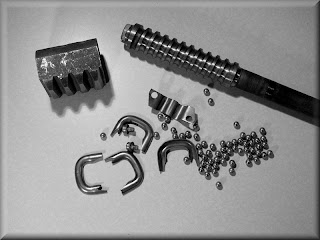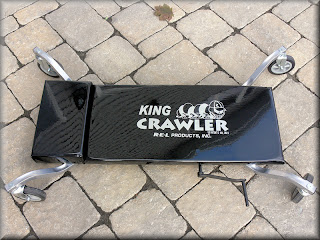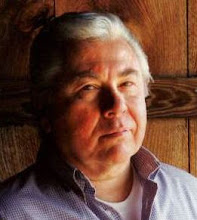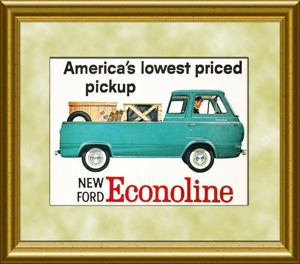Josh W. of Kingsbury, NY owns a very impressive collection of industrial metal working machines including computer controlled lathes and milling machines. The photo below shows the current finished appearance of the two pedals but the real story about the improvements starts below.
 The photo below shows the brake pedal shafts, old and new. The original shaft used a C-clip to hold the pedal assembly to the master cylinder. A brief discussion with Josh ensued and we decided that a threaded shaft with a lock nut would be a better idea.
The photo below shows the brake pedal shafts, old and new. The original shaft used a C-clip to hold the pedal assembly to the master cylinder. A brief discussion with Josh ensued and we decided that a threaded shaft with a lock nut would be a better idea. The photo below shows the old shaft after it was removed from the pedal assembly. The removal was a matter of grinding the weld away and pressing the old shaft out. Jose took careful measurements and used a lathe to turn the new shaft. The shaft was threaded to accept a 5/8" fine thread nylon lock nut.
The photo below shows the old shaft after it was removed from the pedal assembly. The removal was a matter of grinding the weld away and pressing the old shaft out. Jose took careful measurements and used a lathe to turn the new shaft. The shaft was threaded to accept a 5/8" fine thread nylon lock nut. The photo below shows the newly welded shaft in place along with the locknut.
The photo below shows the newly welded shaft in place along with the locknut. The old master cylinder pushrod bolt is on the left in this photo. Notice the extreme amount of erosion of the steel caused by rust. Josh fabricated a new bolt from hex stock and is identical to the factory-supplied bolt with the exception of depth of the hex head. It was decided that deeper is better.
The old master cylinder pushrod bolt is on the left in this photo. Notice the extreme amount of erosion of the steel caused by rust. Josh fabricated a new bolt from hex stock and is identical to the factory-supplied bolt with the exception of depth of the hex head. It was decided that deeper is better. The photo below shows the old sleeve on the bottom and the newly fabricated sleeve on the top. Notice the grooves cut into the old sleeve from many years of non-lubrication and the grinding actions of road debris.
The photo below shows the old sleeve on the bottom and the newly fabricated sleeve on the top. Notice the grooves cut into the old sleeve from many years of non-lubrication and the grinding actions of road debris. These are new bushings for the clutch pedal. I purchased them from Mac's for a couple bucks.
These are new bushings for the clutch pedal. I purchased them from Mac's for a couple bucks. This is how the new bushings look in the old clutch pedal. They are held in place with blue Locktite.
This is how the new bushings look in the old clutch pedal. They are held in place with blue Locktite. The photo below shows the new shaft and bushings in place inside the old clutch pedal assembly.
The photo below shows the new shaft and bushings in place inside the old clutch pedal assembly. Let me conclude this entry by saying that the work that was performed by Josh exceeded my expectations. There is no more free-play in the pedals.
Let me conclude this entry by saying that the work that was performed by Josh exceeded my expectations. There is no more free-play in the pedals.The fabrication of the three items cost approximately $160. Expensive? I don't think it was. It took time to measure, plan and machine these components. Now I have pedals that work like new and the brakes are probably safer than new.
 If you would like to contact me via email click here.
If you would like to contact me via email click here.If you would like to see larger versions of these photos click here.
Enjoy the Ride!


























